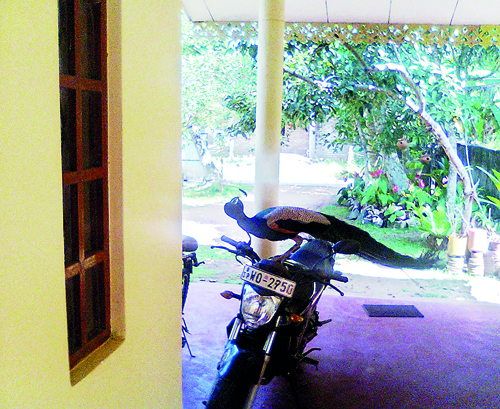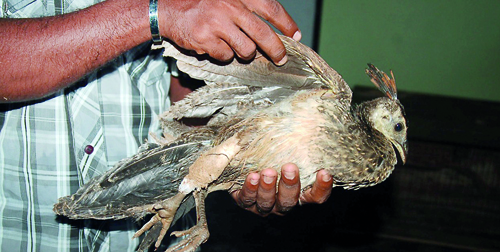Sunday Times 2
This love affair with a beauty is breaking down
A peacock is one of the most beautiful and best-recognised birds in Sri Lanka, and loved by everybody. The bird is also venerated as the vehicle of Lord Kataragama, so people do not harm it.
“Peafowl prefer open habitation to dense forests. Land clearances definitely allowed peafowl to expand their range,” said ornithologist, Prof. Sarath Kotagama.

A peacock pecks at its reflection on a side-mirror of a motorcycle in Polhena, Matara. Photo by H.B.J. Palitha
The problem is that peafowl are omnivorous, eating almost anything from grains, insects, small reptiles, small mammals, berries, drupes (stone fruit), wild figs, and some cultivated crops – even paddy fields are targeted by these large birds.
“Peafowl have now become a big headache for us. They raid our paddy fields and eat the paddy,” said Lakshman, a paddy farmer in Anuradhapura. He said peafowl used not to be a problem in the past; the problem arrived only about 15 years ago.
“Other birds such as parrots raid our paddy fields at specific times either in the morning or late in evening. But peafowl have no specific time, so we have to be vigilant in our paddy fields the whole day,” Lakshman lamented.
“We don’t hate the birds but we can’t afford the loss of our paddy.”
Lakshman said that though the large paddy fields cultivated by his ancestors included a small plot known as “kurulu paluwa” (“birds’ share”) where birds could feed freely, this was not an option for small-scale farmers.
The relationship with peafowl and farmers are not healthy even in India where the peacock is the “National Bird”. Indian media have reported the killing of peafowl with poisoned grain, and of farmers asking for a solution to their plots being raided by the birds.
Sri Lanka’s southern dry zone area near Hambantota is where most people remember seeing peafowl in the past, and they were found in wilderness areas, but now they are spreading towards human habitat.
Villagers in Sitinamaluwa in Tangalle say they find many peafowl in their gardens these days. Some complain that when the birds land on tiled roofs their weight and sharp talons damage the tiles.
Peafowl were not commonly seen around Matara but H.B.J. Palitha, a surveyor living in Polhena, says he now has a family of peafowl visiting his bird feeder.
Mr Palitha was familiar with small birds pecking at their reflection in the rear-view mirror of his motorcycle — but now he finds peafowl attacking their reflection in the mirror, causing considerable damage to the bike.
He recalls that a few peafowl had been reared at a nearby temple and suspects that they have multiplied to become the flock roaming his neighbourhood.
The respectful and loving relationship between these fabulous birds and humans is breaking down as the peafowl expand their range into new terrain. It is time to make a proper evaluation of the issue.
| Wildlife deaths and how to avoid them
The Southern Expressway is a death trap for many animals and birds, with human life also being at risk in collisions — many will remember cricketer-politician Sanath Jayasuriya narrowly escaping injury after hitting a wild boar on the expressway near Pinnaduwa. As the only facility in the area treating injured animals, the Wildlife Conservation Society of Galle’s Wildlife Hospital has been receiving a flow of patients following the opening of Southern Expressway in 2011. “Initially it was domestic dogs that got hit on the expressway,” said WCSG’s President Madura de Silva. “Then other mammals such as ring-tailed civet cats (kola diviya) topped the numbers, followed by porcupines.” Fishing cats and brown mongoose too have been victims. Now it is reported that a number of wild boar have been hit by vehicles. Snakes, including pythons, have been crushed by vehicles. The Southern Expressway cuts across the prime habitat of hog deer, which are on the Critically Endangered list of wildlife, but Mr. de Silva is relieved that no hog deer appear to have become traffic victims. He also said no otters had been reported on the expressway although the road cuts across otter habitat. Mr. de Silva revealed an interesting pattern. “Initially, no bird casualties were recorded but after few weeks we began getting bird victims. Among them were brahminy kites and crested hawk-eagles. It seems these birds of prey scavenge for the remains of animals, particularly rodents, killed in road accidents and themselves fall victim to speeding vehicles as they come to the expressway to feed. What should you do if you encounter wildlife on the road?  Injured animals. Photo courtesy of Wildlife Conservation Society of Galle -Slow down – collision avoidance and driver response time are improved at slower speeds |


